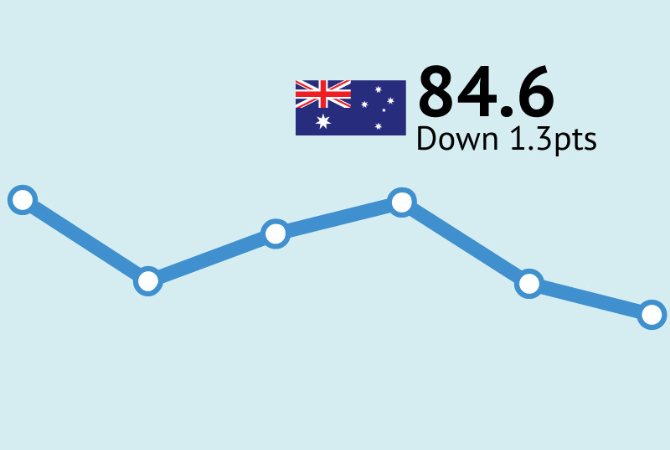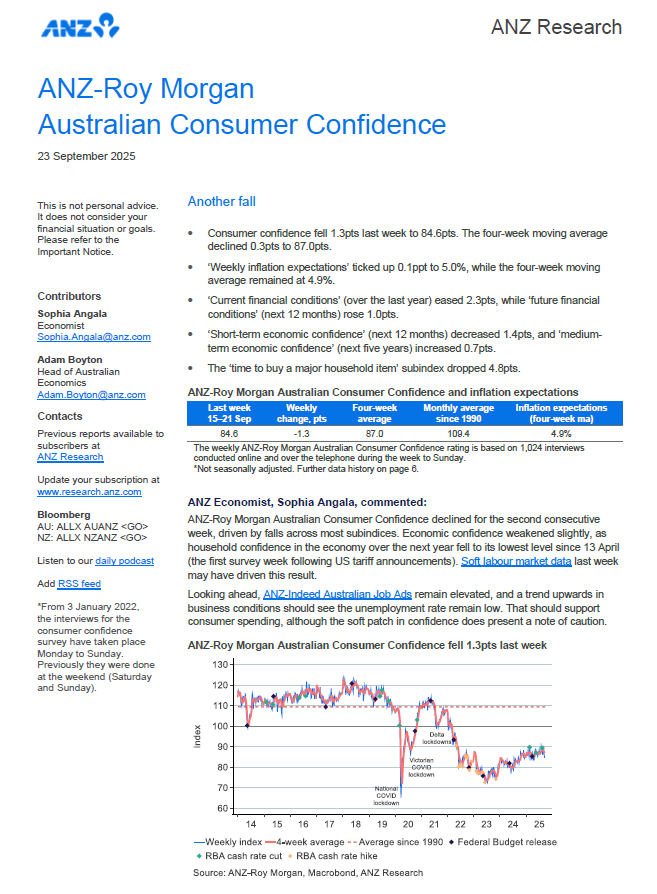ANZ-Roy Morgan Consumer Confidence down 1.3pts to 84.6; lowest rating since the Federal Election in early May

ANZ-Roy Morgan Consumer Confidence dropped 1.3pts to 84.6 this week – the lowest rating since the Albanese Government was re-elected with a greatly expanded majority in early May. Consumer Confidence is now 0.3 points below the same week a year ago, September 16-22, 2024 (84.9), but now 2.2pts below the 2025 weekly average of 86.8.
An analysis by State shows a broad trend with Consumer Confidence falling in the four largest States of New South Wales, Victoria, Queensland and Western Australia, but up in South Australia.
The main driver of this week’s fall in Consumer Confidence was a drop in buying sentiment by a net 5% points to its lowest in a month.
Just over a fifth of Australians, 21% (down 1ppt), say their families are ‘better off’ financially than this time last year compared to 42% (up 2ppts) that say their families are ‘worse off’.
Net views on personal finances over the next year improved marginally with 27% (up 1ppt) of respondents expecting their family will be ‘better off’ financially this time next year, while 32% (down 1ppt) expect to be ‘worse off’.
Net sentiment regarding the economy over the next year weakened slightly this week with just 8% (down 2ppts) of Australians, expecting ‘good times’ for the Australian economy over the next twelve months compared to more than a quarter, 29% (unchanged), that expect ‘bad times’.
Although net views regarding the Australian economy in the longer-term were virtually unchanged this week, positive sentiment about the next five years hit a multi-decade low with only 9% (down 1ppt) of Australians expecting ‘good times’ for the economy over the next five years (the lowest figure for this indicator for over 35 years since June 1990) compared to a just over a quarter, 26% (down 2ppts), expecting ‘bad times’.
Net buying intentions drove this week’s fall with well under a quarter of respondents, 21% (down 3ppts) saying now is a ‘good time to buy’ major household items compared to 34% (up 2ppts) that say now is a ‘bad time to buy major household items’.
ANZ Economist, Sophia Angala, commented:

ANZ-Roy Morgan Australian Consumer Confidence declined for the second consecutive week, driven by falls across most subindices. Economic confidence weakened slightly, as household confidence in the economy over the next year fell to its lowest level since 13 April (the first survey week following US tariff announcements). Soft labour market data last week may have driven this result.
Looking ahead, ANZ-Indeed Australian Job Ads remain elevated, and a trend upwards in business conditions should see the unemployment rate remain low. That should support consumer spending, although the soft patch in confidence does present a note of caution.

Check out the latest results for our weekly surveys on Business Confidence, Consumer Confidence, and Voting Intention as follows:
Roy Morgan Business Confidence Statistics
ANZ – Roy Morgan Consumer Confidence Statistics
Federal Voting – Government Confidence Rating
Related Research Reports
The latest Roy Morgan Consumer Confidence Monthly Report is available on the Roy Morgan Online Store. It provides demographic breakdowns for Age, Sex, State, Region (Capital Cities/ Country), Generations, Lifecycle, Socio-Economic Scale, Work Status, Occupation, Home Ownership, Voting Intention, Roy Morgan Value Segments and more
Consumer Confidence – Monthly Detailed Report in Australia.
Business Confidence – Monthly Detailed Report in Australia.
Consumer Banking Satisfaction - Monthly Report in Australia.
For comments or more information please contact:
Roy Morgan - Enquiries
Office: +61 (03) 9224 5309
askroymorgan@roymorgan.com
Margin of Error
The margin of error to be allowed for in any estimate depends mainly on the number of interviews on which it is based. Margin of error gives indications of the likely range within which estimates would be 95% likely to fall, expressed as the number of percentage points above or below the actual estimate. Allowance for design effects (such as stratification and weighting) should be made as appropriate.
| Sample Size | Percentage Estimate |
| 40% – 60% | 25% or 75% | 10% or 90% | 5% or 95% | |
| 1,000 | ±3.0 | ±2.7 | ±1.9 | ±1.3 |
| 5,000 | ±1.4 | ±1.2 | ±0.8 | ±0.6 |
| 7,500 | ±1.1 | ±1.0 | ±0.7 | ±0.5 |
| 10,000 | ±1.0 | ±0.9 | ±0.6 | ±0.4 |
| 20,000 | ±0.7 | ±0.6 | ±0.4 | ±0.3 |
| 50,000 | ±0.4 | ±0.4 | ±0.3 | ±0.2 |





